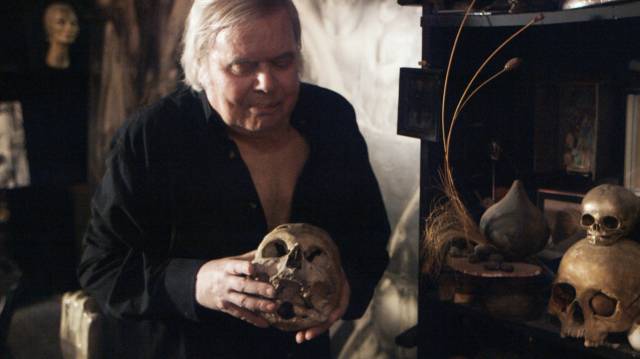

Dark Star: H. R. Giger's World accomplishes something that devotees of the surrealist artist have been hoping for since he first achieved notoriety in 1979 with his work on the film Alien: it tears the lid off of the reclusive artist's life and offers us a glimpse inside. Always more comfortable remaining in the shadows while allowing his work to take center stage, Giger has long been a mystery to his fans. This film successfully removes that veneer of mystery, granting us entree into Giger's private life and humanizing the artist in the process.
While Giger's oeuvre - a thematic triptych consisting of birth, sex, and death – is well-represented, Dark Star is at its best when it treats us to intimate scenes of Giger's daily life – dinners with his entourage, interactions with his agent, and moments with his significant other. Director Belinda Sallin makes excellent use of the elements found in Giger's home; a cramped house/studio combo where the tub is filed with books and the detritus of the artist's life and work inhabit every nook and cranny. Giger himself is revealed as a childlike figure completely at odds with the popular conception of him as some sort of dark maestro - he is shown, for example, riding a miniature train through his yard like some sort of ride in a decrepit carnival, and he greets his guests with kisses on the cheek and offers of homemade cake. For aficionados, however, the most interesting segments will likely be those which show Giger in his prime. We see him with Li Tobler, his model girlfriend during the period of his early fame, whose struggles with depression and the bonds of a strict Catholic upbringing tragically ended in suicide. We are also treated to footage of Giger at work on the set of Alien, and a brief interview snippet with director Ridley Scott.
In the final analysis, however, this is very much a portrait of the artist as an old man. Watching the film, it is obvious that Giger is heading toward a rendezvous with the third part of his thematic triptych – and sure enough, at film's end we are informed that he died very soon after production wrapped. In that sense, the film seems like a work of rescued ethnography worthy of Robert Flaherty – Sallin literally captures Giger's last days, leaving one to wonder if the artist willed himself to live just long enough for the film to be completed as a capstone to his life. The film works on this level, and it is somehow fitting that Giger waited until the very end of his career to step onto the stage himself and show us who he truly is.